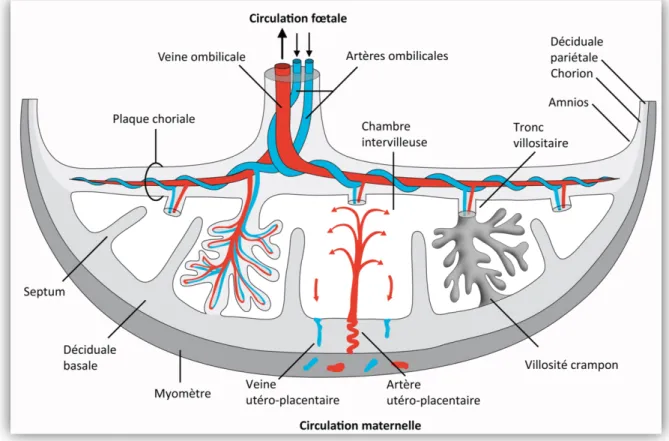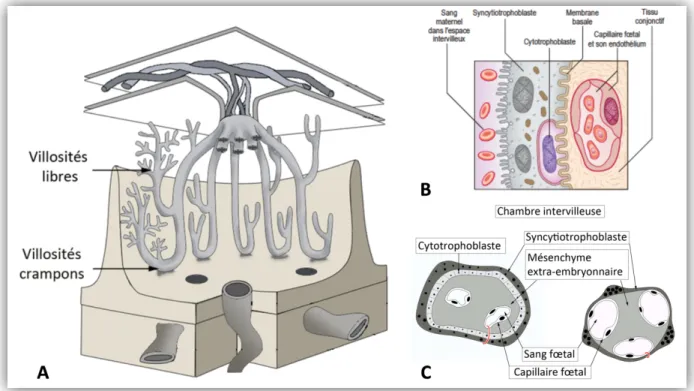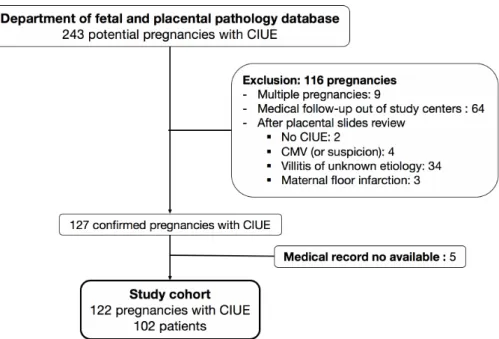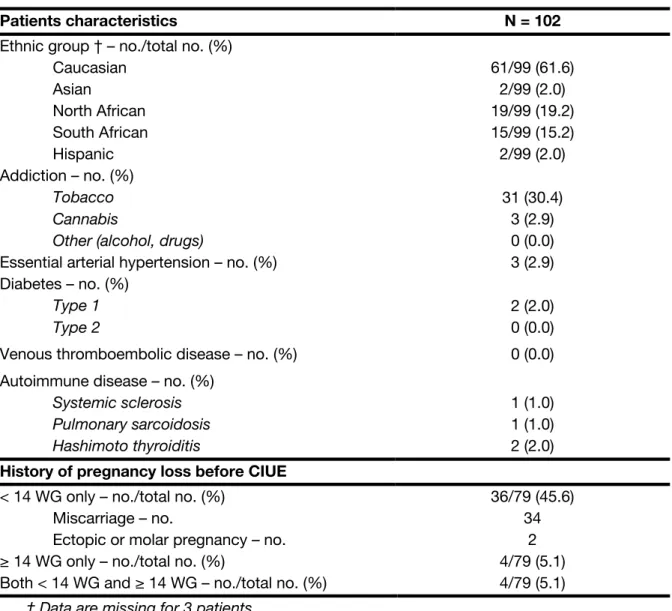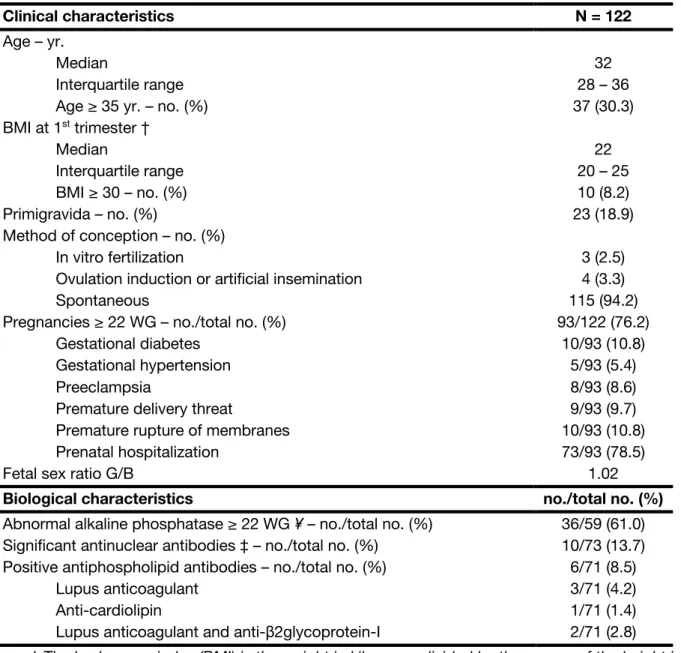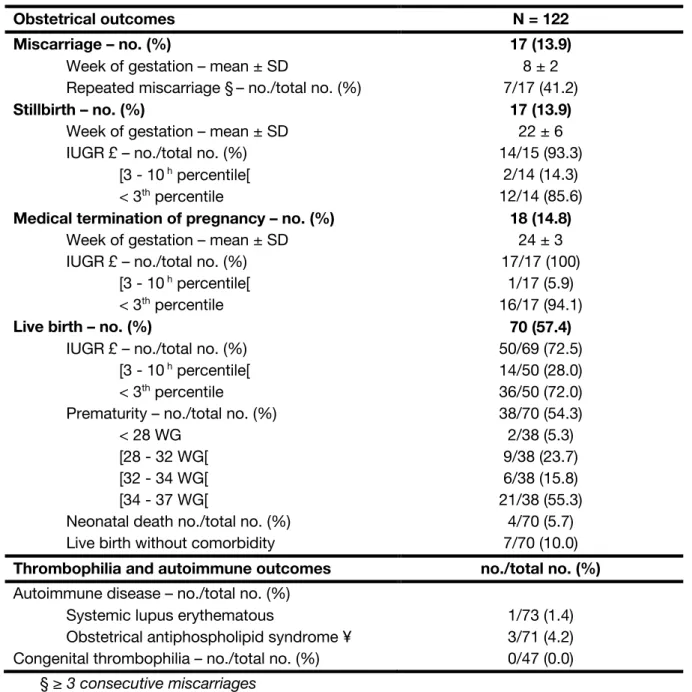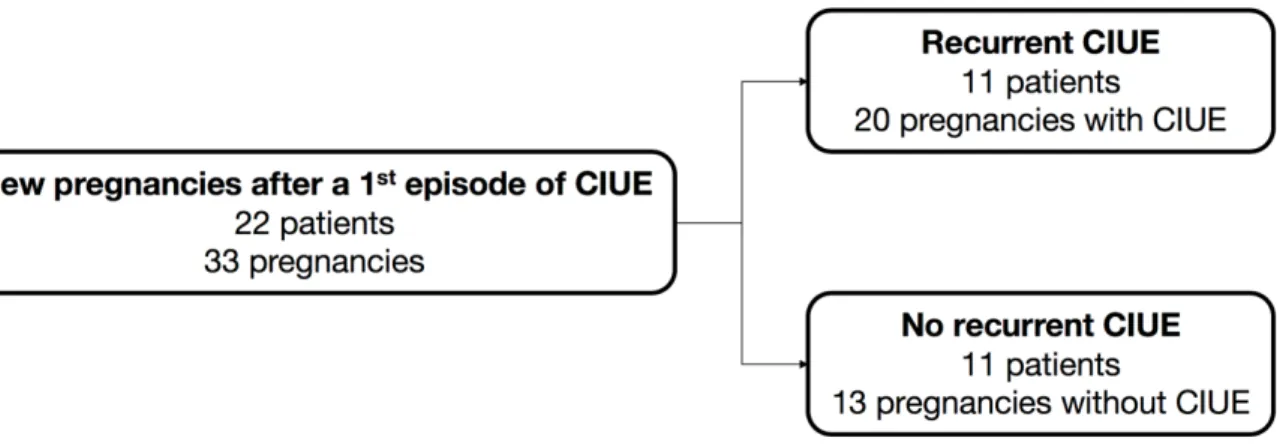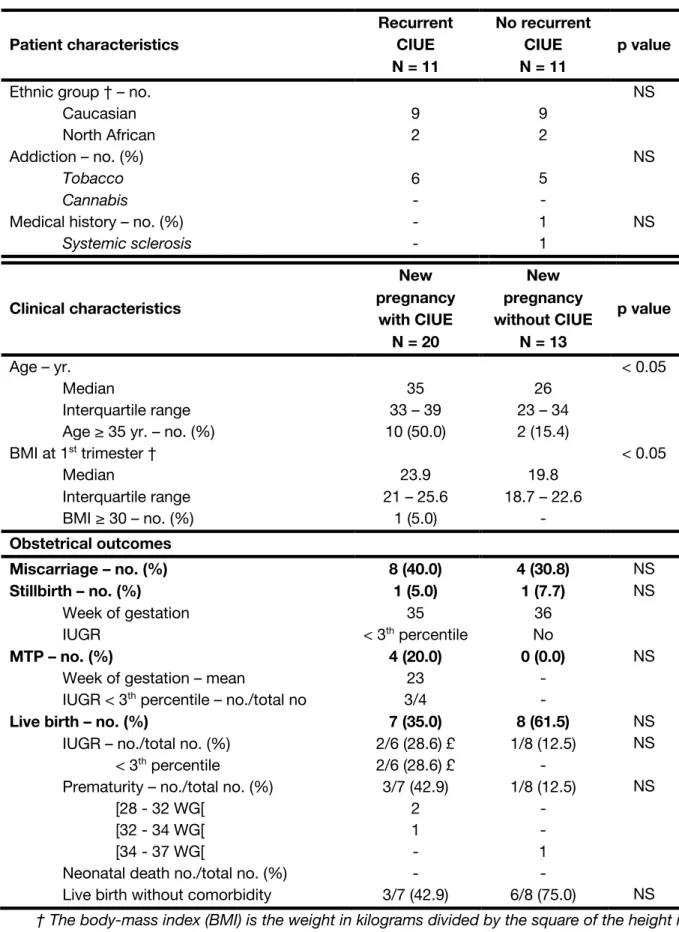HAL Id: dumas-02075907
https://dumas.ccsd.cnrs.fr/dumas-02075907
Submitted on 21 Mar 2019
HAL is a multi-disciplinary open access archive for the deposit and dissemination of sci-entific research documents, whether they are pub-lished or not. The documents may come from teaching and research institutions in France or abroad, or from public or private research centers.
L’archive ouverte pluridisciplinaire HAL, est destinée au dépôt et à la diffusion de documents scientifiques de niveau recherche, publiés ou non, émanant des établissements d’enseignement et de recherche français ou étrangers, des laboratoires publics ou privés.
Issues périnatales de 122 cas d’intervillite chronique
d’étiologie indéterminée : une étude observationnelle
multicentrique
Aurélien Mattuizzi
To cite this version:
Aurélien Mattuizzi. Issues périnatales de 122 cas d’intervillite chronique d’étiologie indéterminée : une étude observationnelle multicentrique. Médecine humaine et pathologie. 2018. �dumas-02075907�
HAL Id: dumas-02075907
https://dumas.ccsd.cnrs.fr/dumas-02075907
Submitted on 21 Mar 2019
HAL is a multi-disciplinary open access archive for the deposit and dissemination of sci-entific research documents, whether they are pub-lished or not. The documents may come from teaching and research institutions in France or abroad, or from public or private research centers.
L’archive ouverte pluridisciplinaire HAL, est destinée au dépôt et à la diffusion de documents scientifiques de niveau recherche, publiés ou non, émanant des établissements d’enseignement et de recherche français ou étrangers, des laboratoires publics ou privés.
Issues périnatales de 122 cas d’intervillite chronique
d’étiologie indéterminée : une étude observationnelle
multicentrique
Aurélien Mattuizzi
To cite this version:
Aurélien Mattuizzi. Issues périnatales de 122 cas d’intervillite chronique d’étiologie indéterminée : une étude observationnelle multicentrique. Médecine humaine et pathologie. 2018. <dumas-02075907>
Université de Bordeaux
U.F.R. DES SCIENCES MEDICALES
Année 2018 Thèse n°3109
Thèse pour l’obtention du DIPLOME d’ETAT de DOCTEUR EN MEDECINE DES GYNÉCOLOGIE-OBSTÉTRIQUE
Présentée et soutenue publiquement le 1er Octobre 2018 Par Aurélien MATTUIZZI
,
né le 17 Avril 1989 à Marmande (47)ISSUES PERINATALES DE 122 CAS
D’INTERVILLITE CHRONIQUE D’ETIOLOGIE INDETERMINEE :
UNE ETUDE OBSERVATIONNELLE MULTICENTRIQUE
Directrice de Thèse
Madame le Professeur Estibaliz LAZARO
Rapporteur
Monsieur le Professeur Patrick BLANCO
Membres du jury
Monsieur le Professeur Loïc SENTILHES...Président Monsieur le Professeur Jacques HOROVITZ...Juge Monsieur le Professeur Patrick BLANCO...Juge Monsieur le Docteur Frédéric COATLEVEN...Juge Madame le Docteur Gwenaëlle ANDRÉ...Juge Madame le Professeur Estibaliz LAZARO...Juge
R
EMERCIEMENTS
À notre Maître et Président du Jury, Monsieur le Professeur Loïc SENTILHES
Professeur des Universités, Praticien Hospitalier Chef de service de Gynécologie-Obstétrique
Maternité du Centre Aliénor d’Aquitaine, CHU de Bordeaux
Vous me faites l’honneur de présider le jury de cette thèse.
Vos connaissances et votre dynamisme universitaire sont un exemple pour moi. Les projets de recherche et d’enseignement que vous me confiez sont extrêmement enrichissants. J’espère être à la hauteur de la confiance que vous m’accordez.
Veuillez trouver dans ce travail, le témoignage de mon plus grand respect et de ma reconnaissance.
À notre Maître et Juge, Monsieur le Professeur Jacques HOROVITZ
Professeur des Universités, Praticien Hospitalier Chevalier des Palmes Académiques
Ancien chef de service de Gynécologie-Obstétrique, Maternité B Maternité du Centre Aliénor d’Aquitaine, CHU de Bordeaux
Vous me faites l’honneur de participer au jury de cette thèse.
Vous m’avez inculqué des valeurs essentielles en Obstétrique : la rigueur et le respect. Je vous remercie d’avoir partagé avec moi votre expérience professionnelle et votre passion pour l’Obstétrique et la Médecine Fœtale.
À notre Maître et Rapporteur, Monsieur le Professeur Patrick BLANCO
Professeur des Universités, Praticien Hospitalier
Directeur adjoint du laboratoire ImmunoConcEPT - CNRS UMR 5164 Chef de service d’Immunologie et d’Immunogénétique
Hôpital Pellegrin, CHU de Bordeaux
Tu m’as fait l’honneur d’être le rapporteur de ce travail.
Travailler à tes côtés au sein du laboratoire ImmunoConcEPT est une chance, tu as su me transmettre ta passion pour la recherche fondamentale et ton ouverture d’esprit sur la science. Je te remercie pour ton soutien, ton dynamisme et ta bienveillance au quotidien.
Sois assuré de ma reconnaissance et de mon profond respect.
À notre Juge, Monsieur le Docteur Frédéric COATLEVEN
Praticien Hospitalier, Gynécologue-Obstétricien
Coordinateur du Centre Pluridisciplinaire de Diagnostic Prénatal Service de Gynécologie-Obstétrique
Maternité du Centre Aliénor d’Aquitaine, CHU de Bordeaux
Tu me fais l’honneur de juger cette thèse.
Tes valeurs, ton parcours et ta rigueur sont un modèle pour moi. J’ai pu prendre confiance en moi grâce à ton enseignement et mieux faire face en présence de situations difficiles. Je te remercie pour la confiance que tu m’accordes et qui me pousse à donner le meilleur de moi-même.
À notre Juge, Madame le Docteur Gwenaëlle ANDRÉ
Praticien Hospitalier, Fœtopathologiste
Service de Pathologie, Unité de Pathologie Fœtale et Placentaire Hôpital Pellegrin, CHU de Bordeaux
Tu me fais l’honneur de juger ce travail.
Tes connaissances en Pathologie et en Anatomie Fœtale sont impressionnantes. Ton enseignement et tes qualités de dessinatrice m’ont énormément apporté. Je te remercie pour ton encadrement et ta bienveillance. Merci également pour tous ces échanges sur l’Éthique, la Recherche, la Médecine, la Vie.
Sois assurée de ma reconnaissance et de mon amitié.
À notre Maître et Directrice de Thèse Madame le Professeur Estibaliz LAZARO
Professeur des Universités, Praticien Hospitalier
Coordinatrice de la réunion de concertation pluridisciplinaire PREGNANT Service de Médecine Interne et de Maladies Infectieuses
Hôpital Haut-Lévêque, CHU de Bordeaux
Merci d’avoir accepté de diriger ce travail.
J’ai toujours admiré ta bienveillance envers les étudiants et les patients durant mon externat. J’ai pu directement en bénéficier au cours de cette année par ton encadrement et ta disponibilité sans faille. Je te remercie pour ta patience, ton dynamisme et ta bonne humeur au quotidien.
À ma famille,
À mes ami.e.s,
À mes co-internes,
Aux équipes de mes différents stages,
- 6 -
T
ABLE DES MATIERES
I. LISTE DES ABREVIATIONS ... 8
-II. CONTEXTE SCIENTIFIQUE ... 9
-PHYSIOLOGIE DES ECHANGES PLACENTAIRES ... -9
-INTERVILLITE CHRONIQUED’ETIOLOGIE INDETERMINEE ... -12
-MECANISMES PHYSIOPATHOLOGIQUES ... -12 -RATIONNEL DE L’ETUDE ... -13 -BIBLIOGRAPHIE ... -14 -III. ARTICLE ... 15 -ABSTRACT ... -16 -MANUSCRIPT ... -17 -INTRODUCTION ... -17
-MATERIAL &METHODS ... -18
-RESULTS ... -20 -DISCUSSION ... -29 -CONCLUSION ... -32 -ACKNOWLEDGMENTS ... -32 -REFERENCES ... -33 -IV. ANNEXES ... 36
-- 7 --
T
ABLE DES ILLUSTRATIONS
CONTEXTE SCIENTIFIQUE
FIGURE 1.CIRCULATION MATERNELLE ET FŒTALE AU SEIN DU PLACENTA ... -9
-FIGURE 2.UNITE FONCTIONNELLE DU PLACENTAET BARRIERE PLACENTAIRE ... -11
-FIGURE 3.REPRESENTATION SCHEMATIQUE D’UNE CHAMBRE INTERVILLEUSE PLACENTAIRE ... -13
ARTICLE FIGURE 1.FLOW CHART OF THE 122CIUE INCLUDED IN THE STUDY...-26-
FIGURE 2.DISTRIBUTION OF THE PATIENTS WITH A NEW PREGNANCY AFTER CIUE...-31-
TABLE 1.MATERNAL CHARACTERISTICS AND OBSTETRICAL HISTORY ... -21-
TABLE 2.CHARACTERISTICS OF PREGNANCIES WITH CIUE ... -22-
TABLE 3.PERINATAL OUTCOMES OF PREGNANCIES WITH CIUE ... -24-
TABLE 4.CHARACTERISTICS AND OUTCOMES OF RECURRENT CIUE ... -26-
TABLE 5.DETAIL OF THERAPEUTIC INTERVENTION IN ORDER TO PREVENT A RECURRENCE OF CIUE ... -27-
TABLE 6.HISTOPATHOLOGICAL CHARACTERISTICS OF CIUE AFTER 14WG ... -28
ANNEXES ANNEXE 1.COUPE HISTOLOGIQUE D’UN PLACENTA SAIN A TERME (A) VS ATTEINT DE CIUE(B) ... -36
-ANNEXE 2.GRADATION DE L’INFILTRAT MACROPHAGIQUE DES CIUE ... -36
-- 8 --
I. L
ISTE DES ABREVIATIONS
aPL: Antiphospholipid AZA: Azathioprin BMI: Body Mass Index
CIUE: Chronic Intervillositis of Unknown Etiology HCQ: Hydroxychloroquine
HES: Hematoxylin–Eosin–Saffron IUGR: Intra-Uterine Growth Retardation LDA: Low Dose Aspirin
LMWH: Low Molecular Weight Heparin MTP: Medical Termination of Pregnancy
MVM: Maternal Vascular Malperfusion of the placental bed NS: Not Significant
PIg: Polyvalent Immunoglobulins PROM: Premature Rupture Of Membrane WG: Week of Gestation
- 9 -
II. C
ONTEXTE SCIENTIFIQUE
P
HYSIOLOGIE DES ECHANGES PLACENTAIRES
Le placenta est un organe transitionnel constituant une interface permettant le développement et la protection du fœtus tout au long de la grossesse. Il se compose de deux secteurs ayant un rôle anatomique et fonctionnel essentiel dans les échanges materno-fœtaux (Figure 1) : (i) la plaque basale, ancrée dans la muqueuse utérine maternelle qui permet de maintenir un lien étroit avec le réseau artériel utérin afin de vasculariser la chambre intervilleuse ; (ii) la plaque choriale,
constituée de l’arbre villositaire, dont les vaisseaux se réunissent pour former le réseau chorio-allantoïdien puis les vaisseaux du cordon ombilical (1–3).
Figure 1. Circulation maternelle et fœtale au sein du placenta
- 10 -
L’arbre villositaire, situé au sein de la chambre intervilleuse, constitue l’unité
fonctionnelle du placenta (Figure 2A). Il est composé de ramifications, appelées villosités, formées à partir d’un axe mésenchymateux contenant les vaisseaux fœtaux chorio-allantoïdien. Il existe deux types de villosités : (i) les villosités crampons, permettant un ancrage de l’arbre au niveau de la plaque basale ; (ii) les villosités libres, ayant pour principale fonction d’augmenter la surface d’échange materno-fœtale. L’axe mésenchymateux des villosités choriales est tapissé par une double couche cellulaire appelée trophoblaste se divisant en : (i) cytotrophoblaste,
couche cellulaire interne, qui fusionne et forme (ii) le syncytiotrophoblaste, couche
cellulaire externe multi-nucléée. Le cytotrophoblaste et le syncytiotrophoblaste, en
association avec l’endothélium des capillaires fœtaux, constituent une véritable
barrière placentaire (Figure 2B) régulant les échanges materno-fœtaux. Au cours
de la grossesse, on observe un amincissement progressif de cette barrière, ceci afin de s’adapter aux besoins croissants en oxygène et en nutriments du fœtus (Figure 2C) (1–3).
Les échanges placentaires sont permis par l’apport de sang maternel, riche en nutriments et en oxygène, au niveau de la chambre intervilleuse par l’intermédiaire des artères utéroplacentaires. Les nutriments et l’oxygène rejoignent alors la circulation fœtale par l’intermédiaire des villosités choriales à travers le syncytiotrophoblaste et le cytotrophoblaste (1–3). À l’inverse, le dioxyde de carbone et les déchets nutritifs sont libérés à partir de la circulation fœtale dans la chambre intervilleuse puis rejoignent la circulation maternelle par l’intermédiaire des veines utéroplacentaires afin d’être épurés par les organes maternels (1–3).
- 11 -
Figure 2. Unité fonctionnelle du placenta et barrière placentaire
A – Schéma tridimensionnel du contenu de la chambre intervilleuse : l’arbre villositaire B – La barrière placentaire
C – Coupe horizontale d’une villosité choriale libre au 1er trimestre versus à terme
©André G., Unité de Pathologie Fœtale et placentaire, CHU de Bordeaux ©Mitchell BS, Sharma RP. Embryologie. Paris : Elsevier, 2005.
- 12 -
I
NTERVILLITE CHRONIQUE
D
’
ETIOLOGIE INDETERMINEE
Mécanismes physiopathologiques
L’intervillite chronique est une pathologie rare du placenta caractérisée par une altération des échanges au niveau de la barrière placentaire. Cette pathologie, volontiers récidivante, peut être responsable au 1er trimestre de fausses couches
spontanées précoces, et, aux 2ème et 3ème trimestre causer des retards de
croissance intra-utérins souvent sévères et parfois précoces pouvant se solder
par une mort fœtale in utero (4). Ces conséquences obstétricales, souvent graves,
rendent donc difficile l’obtention d’une naissance vivante pour les patientes atteintes.
Initialement décrite par Labarrere et Mullen en 1987 (5), elle se caractérise sur un plan anatomopathologique par un infiltrat leucocytaire principalement
macrophagique (80%) et lymphocytaire (20%) de la chambre intervilleuse. La
réaction inflammatoire en résultat est responsable d’une nécrose du syncytiotrophoblaste et du cytotrophoblaste villeux générant des dépôts fibrinoïdes cicatriciels sur l’arbre villositaire (5). La barrière placentaire ainsi altérée
n’est plus en capacité d’assurer les échanges nécessaires à la croissance embryonnaire ou fœtale de manière satisfaisante, expliquant les conséquences obstétricales observées (Figure 3).
La cause précise des intervillites chroniques reste à ce jour inconnue, mais plusieurs hypothèses sont avancées : une rupture de tolérance à l’égard des antigènes fœtaux (6), une réaction immunologique à des antigènes bactériens mal jugulée (7) ou encore des mécanismes d’auto-immunité par dérèglement des lymphocytes T régulateurs placentaires (8). Un projet de recherche est actuellement mené par notre équipe sur le sujet et des données préliminaires suggèrent l’implication d’une cytokine pro-inflammatoire, l’IL-1ß, et du complexe multi-protéique la produisant : l’inflammasome.
- 13 -
Figure 3. Représentation schématique d’une chambre intervilleuse placentaire
(A) Placenta normal (B) Placenta atteint de CIUE
©André G., Unité de Pathologie Fœtale et placentaire, CHU de Bordeaux
Rationnel de l’étude
L’intervillite chronique d’étiologie indéterminée est une pathologie souvent lourde de conséquences pour les patientes atteintes. Il s’agit cependant d’une pathologie rare souvent méconnue des obstétriciens et des anatomopathologistes. À ce jour, la cohorte décrite la plus conséquente est celle de Marchaudon et al. (4), en 2011, comportant 69 grossesses atteintes d’intervillite chronique d’étiologie indéterminée pour 50 patientes. Par ailleurs, les thérapeutiques actuellement proposées sont mal codifiées du fait du manque de connaissance de la physiopathologie et de l’absence d’étude randomisée suffisamment puissante pour évaluer leur efficacité.
La description de notre cohorte rétrospective multicentrique comportant 122 cas d’intervillite chronique d’étiologie indéterminée chez 102 patientes semble donc être pertinente afin d’apporter des éléments plus robustes aux praticiens et ainsi permettre de mieux codifier la prise en charge et améliorer l’information donnée aux patientes atteintes par cette pathologie.
- 14 -
B
IBLIOGRAPHIE
1. Nessmann C, Larroche J-C. Atlas de pathologie placentaire. Paris : Masson ; 2001.
2. Evain-Brion D. Le placenta humain. Cachan : Éditions médicales internationales ; 2010.
3. Lecarpentier E, Fournier T, Guibourdenche J, Gil S, Tsatsaris V. Le placenta humain. 3 avr 2015;
4. Marchaudon V, Devisme L, Petit S, Ansart-Franquet H, Vaast P, Subtil D. Chronic histiocytic intervillositis of unknown etiology: Clinical features in a consecutive series of 69 cases. Placenta. févr 2011;32(2):140‑5.
5. Labarrere C, Mullen E. Fibrinoid and trophoblastic necrosis with massive chronic intervillositis: an extreme variant of villitis of unknown etiology. Am J Reprod Immunol Microbiol AJRIM. nov 1987;15(3):85‑91.
6. Capuani C, Meggetto F, Duga I, Danjoux M, March M, Parant O, et al. Specific infiltration pattern of FOXP3+ regulatory T cells in chronic histiocytic intervillositis of unknown etiology. Placenta. 1 févr 2013;34(2):149‑54.
7. Hussein K, Stucki-Koch A, Kreipe H, Feist H. Expression of Toll-Like Receptors in Chronic Histiocytic Intervillositis of the Placenta. Fetal Pediatr Pathol. 2 nov 2015;34(6):407‑12.
8. Clark DA, Dmetrichuk JM, McCready E, Dhesy‐Thind S, Arredondo JL. Changes in expression of the CD200 tolerance-signaling molecule and its receptor (CD200R) by villus trophoblasts during first trimester missed abortion and in chronic histiocytic intervillositis. Am J Reprod Immunol. 2017;78(1):e12665.
- 15 -
III. A
RTICLE
ISSUES PERINATALES DE 122 CAS
D’INTERVILLITE CHRONIQUE D’ETIOLOGIE INDETERMINEE :
UNE ETUDE OBSERVATIONNELLE MULTICENTRIQUE
PERINATAL OUTCOMES OF 122 CASES
OF CHRONIC INTERVILLOSITIS OF UNKNOWN ETIOLOGY:
AN OBSERVATIONAL MULTICENTER STUDY
Authors: Aurélien Mattuizzi1,6, Fanny Sauvestre MD2,6, Gwenaëlle André MD2, Marion Poingt MD3, Camille Camberlein1, Dominique Carles MD2, Fanny Pelluard MD2, Patrick Blanco MD, PhD4,6, Loïc Sentilhes MD, PhD1, Estibaliz Lazaro MD, PhD5,6
1Department of Obstetrics and Gynecology, Bordeaux University Hospital, Bordeaux, France. 2Department of Pathology, Bordeaux University Hospital, Bordeaux, France.
3Department of Obstetrics and Gynecology, Bordeaux Nord Polyclinic, Bordeaux, France. 4Department of Immunology, Bordeaux University Hospital, Bordeaux, France.
5Department of Internal Medicine, Bordeaux University Hospital, Bordeaux, France. 6CNRS-UMR 5164, ImmunoConcEpT, Bordeaux University, Bordeaux, France.
Keywords: chronic intervillositis, placenta, pregnancy, perinatal outcomes, miscarriage, stillbirth, intra-uterine growth retardation, recurrence
- 16 -
A
BSTRACT
Context. Chronic intervillositis of unknown etiology (CIUE) is a rare placental pathology characterized by a macrophage infiltration of the intervillous space and associated with severe obstetrical complications. Only limited retrospective case-series have been described and prognostic factors associated to perinatal issues remain to be elucidated.
Objective. We aimed to describe maternal characteristics, obstetrical features, outcomes and placental histopathology of 122 CIUE.
Methods. We conducted a multicenter retrospective study in five centers between 1st January 1997 and 31 July 2018. Potential CIUE diagnosis were screened in the
database of Fetal and Placental pathology department. Multiple pregnancies and pregnancies with medical follow-up out of study centers were excluded. Cases with an histopathologic diagnosis of CIUE confirmed according to standardize criterion were included. This study received approval of the Research Ethics Board.
Results. 122 pregnancies (102 patients) with CIUE were included in the study. Pregnancy loss rates were high with 17 (13.9%) miscarriages, 17 (13.9%) stillbirths and 18 (14.8%) medical termination of pregnancy. Of the 70 (57.4%) pregnancies which lead to a live birth, 38 (54.3%) newborns were premature and 50 (71%) were complicated by intra uterine growth retardation (IUGR). Among the 102 patients, 22 patients had subsequent pregnancy and half of them developed a recurrent CIUE. The different therapeutic combinations proposed in our cohort did not impact on perinatal outcomes or recurrence prevention. Gradation of macrophage infiltrate was the only feature significantly associated with perinatal issue (p < 0.05).
Conclusion. This study provides an extensive description of the largest cohort of CIUE reported in the literature. It confirms that CIUE is associated with high rates of adverse pregnancy outcomes including pregnancy loss, IUGR and preterm birth, and also identifies macrophagic infiltration as an important prognostic factor. Larger multicenter cohort and prospective randomized controlled trial for treatment are needed to improve knowledge and care of patients with CIUE.
- 17 -
M
ANUSCRIPT
Introduction
Chronic intervillositis of unknown etiology (CIUE) is a rare placental pathology firstly described by Labarrere and Mullen in 1987 (1). It is histologically characterized by an extensive leukocyte infiltration of the intervillous space, mainly mononuclear cells of maternal origin (1,2). The immune cell infiltrate is associated with a local inflammation of the intervillous space and lead to trophoblast necrosis and fibrin deposit (1,2). CIUE affects placental exchanges and is associated with severe perinatal outcomes as miscarriages or severe intra-uterine growth retardation (IUGR) mostly resulting in stillbirth or induced prematurity (3). Patients with a first episode of CIUE present a high risk of recurrence in subsequent pregnancies. (3).
Since the first anatomopathological description of Labarrere and Mullen (1), many terms have been used to describe this severe and recurrent disease such as “chronic histiocytic intervillositis” or “massive chronic intervillositis” or “intervillitis”. Infectious differential diagnosis was later described as associated with this anatomopathological feature (4–7). Distinguish terms referring to a histologic placenta lesion without any regard for the cause is nonetheless necessary (8).
Chronic intervillositis of unknown etiology, proposed by Parant et al. in 2009 (9),
implies the absence of a known cause associated to the disease.
It is very difficult to estimate the prevalence of CIUE, a rate between 8 to 9.6‰ in spontaneous abortions (10,11) and 0.6 to 3.2‰ in the second and third trimester placentas (9,10) have been reported. According to these findings, CIUE is frequently misunderstood by perinatology actors and probably underdiagnosed. At present, epidemiological data of CIUE outcomes mostly comes from small cohorts (1–3,9– 17).
The principal objective of this study is to report clinical features, obstetrical characteristics and perinatal outcomes of 122 pregnancies with CIUE among 102 patients. Secondary objectives aim to explore if there are prognosis factors involved in perinatal outcomes and in CIUE recurrences, focusing on clinical features, therapeutic interventions and anatomopathological characteristics of CIUE.
- 18 -
Material & Methods
Population study
We conducted a multicenter retrospective chart review of consecutive cases with an histopathologic diagnosis of CIUE between January 1997 and July 2018, at our Fetal and Placental pathology department (Bordeaux hospital university). Pregnancies with a CIUE diagnosis and followed in a center included in the Perinat Aquitaine network were included. Multiple pregnancies were excluded.
Screening criteria
Cases were identified through a search of the Department of Histopathology’s placenta database by using the search term “intervillositis”. Serial 2 µm sections of formalin-fixed paraffin-embedded of potential CIUE tissues were stained with hematoxylin–eosin–saffron (HES) or immuno-stained with anti-CD68 antibodies.
Diagnosis of CIUE was confirmed according to criteria proposed by Bos et al. (8): (i) an infiltrate is present in the intervillous space (ii) approximately 80% of the mononuclear-cells in the intervillous space are CD68-positive cells (iii) the intervillous space should be occupied by an infiltrate for 5% or more (iv) cases with clinical or histopathological signs of infection should be excluded.
A quantitative gradation of mononuclear cells infiltration of the intervillous space was realized according to the classification proposed by Rota et al. (18): [Grade I] infiltrate represents 5 to 10% of intervillous space ; [Grade II] infiltrate represents 10 to 50% of the intervillous space ; [Grade III] infiltrate represents more than 50% of the intervillous space. A quantitative gradation of fibrin deposit (absent, low, high) and associated villitis (absent, low, high) were carried out. Associated Maternal Vascular Malperfusion of the placental bed (MVM) (19) were also noticed.
- 19 - Data collection
Maternal and obstetrical data were collected from each patient’s obstetrical records.
For each patient, clinical characteristics were noted when available: ethnicity, addiction, medical and obstetrical history. Obstetrical data included age, body mass index (BMI), parity, method of conception, pathology associated with pregnancy, need for prenatal hospitalization more than 24h. Maternal laboratory results included alkaline phosphatase, antinuclear antibodies and antiphospholipid antibodies. Phosphatase alkaline reference ranges were defined according to published data specific to pregnancy (20). Antinuclear antibodies were considered as positive over 1/250 dilution. Antiphospholipid antibodies included lupus anticoagulant, anti-cardiolipin, and/or anti-β2 glycoprotein I antibodies. Adverse pregnancy outcomes identified were miscarriage (defined as an early pregnancy loss before 14 WG), stillbirth (defined as an in-utero death at or after 14 WG), and medical termination of pregnancy (MTP). Neonatal outcomes were defined as gestational age of birth, sex, weight, weight percentile according to AUDIPOG curves for live birth (21) or anthropometric norms used in Fetal and Pathology Department for stillbirth or MTP (22). Maternal and obstetrical data on subsequent pregnancies after CIUE were collected. Comparisons between the characteristics of pregnancies complicated or not by CIUE were performed.
This study received approval of the Research Ethics Board. Statistical analysis
Quantitative variables are presented as mean with standard deviation or as median with interquartile range, and qualitative variables are presented as percentages. The non-parametric Mann-Whitney test was used to perform a univariate analysis of quantitative variable, and the Fisher’s exact test was used when the number of individuals was low. Correlation between quantitative variables were performed with the Spearman nonparametric test. All tests were bilateral. P values less than 0.05 were considered statistically significant.
All analyzes were performed with GraphPad Prism software version 7.0a (GraphPad Software, La Jolla, USA).
- 20 -
Results
Patients and pregnancies characteristics
Our chart review revealed 243 cases of CIUE registered in the database of the Fetal and Placental pathology department of our tertiary care university hospital. Figure 1 shows a flowchart of the inclusion and exclusion of all cases. 122 cases were excluded for the following reasons: 9 multiple pregnancies, 64 medical follow-ups out of study centers, 43 without an histopathology of CIUE and 5 medical record no available. A total of 122 pregnancies (corresponding to 102 patients) met inclusion criteria among the 243 potential cases.
Figure 1. Flow chart of the 122 CIUE included in the study
Maternal characteristics and obstetrical history are presented in Table 1. Most patients of the cohort were Caucasian (61.6%) and smokers (30.4%). Only 4 patients (4.0%) reported an history of autoimmune disease before their first episode of CIUE and 5 (4.9 %) had a prior history of hypertension or diabetes. No other medical comorbidities were identified. Seventy-nine patient were multigravida before CIUE index case. Half of them had previous history of pregnancy loss: 45.6% before 14 weeks of gestation (WG) only, 5.1% after 14 WG only and 5.1% with pregnancy
- 21 -
losses both before and after 14 WG. The average number of prior pregnancy losses was 1.
Table 1. Maternal characteristics and obstetrical history
Patients characteristics N = 102
Ethnic group † – no./total no. (%) Caucasian Asian North African South African Hispanic 61/99 (61.6) 2/99 (2.0) 19/99 (19.2) 15/99 (15.2) 2/99 (2.0) Addiction – no. (%) Tobacco Cannabis
Other (alcohol, drugs)
31 (30.4) 3 (2.9) 0 (0.0)
Essential arterial hypertension – no. (%) 3 (2.9)
Diabetes – no. (%)
Type 1 Type 2
2 (2.0) 0 (0.0)
Venous thromboembolic disease – no. (%) 0 (0.0)
Autoimmune disease – no. (%)
Systemic sclerosis Pulmonary sarcoidosis Hashimoto thyroiditis 1 (1.0) 1 (1.0) 2 (2.0)
History of pregnancy loss before CIUE
< 14 WG only – no./total no. (%) Miscarriage – no.
Ectopic or molar pregnancy – no. ≥ 14 WG only – no./total no. (%)
Both < 14 WG and ≥ 14 WG – no./total no. (%)
36/79 (45.6) 34
2 4/79 (5.1) 4/79 (5.1)
† Data are missing for 3 patients.
Maternal and biological characteristics of the 122 pregnancies with CIUE are outlined in Table 2. Median age was 32 years, and 37% of the pregnant women had 35 years or more. Most of them had a normal BMI, only 8.2 % suffered from obesity. Only 18.9% were primigravida. Almost all of the pregnancies were obtained spontaneously. Among the 93 pregnancies which reached 22 WG or more, a prenatal hospitalization was required for 73 (78.5%), mostly because IUGR. Preeclampsia and premature rupture of membranes (PROM) concern respectively 8.6 % and 10.8 % of the pregnancies.
- 22 -
Alkaline phosphatase was measured in 59 pregnancies which reached at least 22 WG. Using the suggested ranges of 126 UI/L and 229 UI/L for respectively the second and third trimesters (20), we noted an abnormal level in 61% of the pregnancies. Alkaline phosphatase level was nonetheless not significantly different in cases of loss of pregnancy versus live birth (median respectively at 296.5 IU/L versus 265 IU/L, p = 0.44) and was not correlated with weight birth percentile (p = 0.23, r = -0.16). Antinuclear and antiphospholipid antibodies were present in 13.7% and 8.5% of the pregnancies with autoimmune investigations.
Table 2. Characteristics of pregnancies with CIUE
Clinical characteristics N = 122
Age – yr. Median
Interquartile range Age ≥ 35 yr. – no. (%)
32 28 – 36 37 (30.3) BMI at 1st trimester † Median Interquartile range BMI ≥ 30 – no. (%) 22 20 – 25 10 (8.2) Primigravida – no. (%) 23 (18.9)
Method of conception – no. (%) In vitro fertilization
Ovulation induction or artificial insemination Spontaneous
3 (2.5) 4 (3.3) 115 (94.2) Pregnancies ≥ 22 WG – no./total no. (%)
Gestational diabetes Gestational hypertension Preeclampsia
Premature delivery threat
Premature rupture of membranes Prenatal hospitalization 93/122 (76.2) 10/93 (10.8) 5/93 (5.4) 8/93 (8.6) 9/93 (9.7) 10/93 (10.8) 73/93 (78.5)
Fetal sex ratio G/B 1.02
Biological characteristics no./total no. (%)
Abnormal alkaline phosphatase ≥ 22 WG ¥ – no./total no. (%) 36/59 (61.0) Significant antinuclear antibodies ‡ – no./total no. (%) 10/73 (13.7) Positive antiphospholipid antibodies – no./total no. (%)
Lupus anticoagulant Anti-cardiolipin
Lupus anticoagulant and anti-β2glycoprotein-I
6/71 (8.5) 3/71 (4.2) 1/71 (1.4) 2/71 (2.8)
† The body-mass index (BMI) is the weight in kilograms divided by the square of the height in meters.
‡ ≥ 1/250
¥ Alkaline phosphatase level was defined as abnormal when it exceeded 126 UI/L and 229 UI/L for respectively the second and third trimesters (20).
- 23 - Perinatal outcomes
The detail of perinatal outcome is provided in Table 3. Miscarriage was reported in 17 (13,9 %) out of 122 pregnancies. More than forty percent of them occurred in a context of recurrent miscarriages. Seventeen pregnancies (13.9%) lead to a stillbirth, due to an IUGR for 14 of them (93.3%, weight data is missing for 2 neonates). A medical termination of pregnancy for very early IUGR was performed in 18 pregnancies (14.8%). Among the 70 pregnancies which lead to a live birth (57.4%), 72.5% presented an IUGR and 54.3% were premature. Four neonates (5.7%) died before the 28th day of life. Only 10% of the live birth reached 37 WG without any
weight restriction. IUGR was reported in 79.2% of all birth after 14 WG (80/101, weight data are missing for 4 neonates).
Autoimmune investigations revealed one case of systemic lupus erythematous associated with an antiphospholipid (aPL) syndrome and two cases of obstetrical aPL syndrome.
- 24 -
Table 3. Perinatal outcomes of pregnancies with CIUE
Obstetrical outcomes N = 122
Miscarriage – no. (%)
Week of gestation – mean ± SD
Repeated miscarriage §– no./total no. (%)
17 (13.9)
8 ± 2 7/17 (41.2)
Stillbirth – no. (%)
Week of gestation – mean ± SD IUGR £ – no./total no. (%)
[3 - 10 h percentile[ < 3th percentile 17 (13.9) 22 ± 6 14/15 (93.3) 2/14 (14.3) 12/14 (85.6)
Medical termination of pregnancy – no. (%)
Week of gestation – mean ± SD IUGR £ – no./total no. (%)
[3 - 10 h percentile[ < 3th percentile 18 (14.8) 24 ± 3 17/17 (100) 1/17 (5.9) 16/17 (94.1)
Live birth – no. (%)
IUGR £ – no./total no. (%) [3 - 10 h percentile[ < 3th percentile
Prematurity – no./total no. (%) < 28 WG
[28 - 32 WG[ [32 - 34 WG[ [34 - 37 WG[
Neonatal death no./total no. (%) Live birth without comorbidity
70 (57.4) 50/69 (72.5) 14/50 (28.0) 36/50 (72.0) 38/70 (54.3) 2/38 (5.3) 9/38 (23.7) 6/38 (15.8) 21/38 (55.3) 4/70 (5.7) 7/70 (10.0)
Thrombophilia and autoimmune outcomes no./total no. (%)
Autoimmune disease – no./total no. (%) Systemic lupus erythematous
Obstetrical antiphospholipid syndrome ¥
1/73 (1.4) 3/71 (4.2) Congenital thrombophilia – no./total no. (%) 0/47 (0.0)
§ ≥ 3 consecutive miscarriages
£ Weight data are missing for 2 stillbirth, 1 medical termination of pregnancy and 1 live birth ¥ According to Sapporo criteria (23). Antibodies positivity was confirmed 12 weeks after delivery
- 25 - Recurrent CIUE
Distribution of new pregnancies with or without CIUE and patients with or without recurrent CIUE is provided in Figure 2. Twenty-two of the 102 women (21.6%) had at least one new pregnancy after the first episode of CIUE. These 22 women had 33 pregnancies. Half of them developed a new CIUE. The median number of recurrences was one. No pregnancies with recurrent CIUE were reported with a different father or gametes donation.
Figure 2. Distribution of the patients with a new pregnancy after CIUE
We compared maternal characteristics and obstetrical outcomes (Table 4) between the groups with and without CIUE recurrence. New pregnant women with CIUE recurrence appeared older than those without CIUE (respectively 35 years versus 26 years, p < 0.05) and with a BMI significantly higher (23.9 versus 19.8 kg/m2, p < 0.05). We did not identify any other difference in the maternal
characteristics neither obstetrical outcomes in both groups. A higher rate of live birth after 37 WG without any weight restriction was nonetheless noticed in the pregnancy group without CIUE (75% versus 42.9%, not significant). For patients with recurrent CIUE, CIUE recurrences were not associated with a worse perinatal prognosis than the CIUE index case (data not shown).
- 26 -
Table 4. Characteristics and outcomes of recurrent CIUE Patient characteristics Recurrent CIUE N = 11 No recurrent CIUE N = 11 p value
Ethnic group † – no. Caucasian North African 9 2 9 2 NS Addiction – no. (%) Tobacco Cannabis 6 - 5 - NS
Medical history – no. (%)
Systemic sclerosis - - 1 1 NS Clinical characteristics New pregnancy with CIUE N = 20 New pregnancy without CIUE N = 13 p value Age – yr. Median Interquartile range Age ≥ 35 yr. – no. (%)
35 33 – 39 10 (50.0) 26 23 – 34 2 (15.4) < 0.05 BMI at 1st trimester † Median Interquartile range BMI ≥ 30 – no. (%) 23.9 21 – 25.6 1 (5.0) 19.8 18.7 – 22.6 - < 0.05 Obstetrical outcomes Miscarriage – no. (%) 8 (40.0) 4 (30.8) NS Stillbirth – no. (%) Week of gestation IUGR 1 (5.0) 35 < 3th percentile 1 (7.7) 36 No NS MTP – no. (%)
Week of gestation – mean
IUGR < 3th percentile – no./total no
4 (20.0) 23 3/4 0 (0.0) - -NS
Live birth – no. (%)
IUGR – no./total no. (%) < 3th percentile
Prematurity – no./total no. (%) [28 - 32 WG[
[32 - 34 WG[ [34 - 37 WG[
Neonatal death no./total no. (%) Live birth without comorbidity
7 (35.0) 2/6 (28.6) £ 2/6 (28.6) £ 3/7 (42.9) 2 1 - - 3/7 (42.9) 8 (61.5) 1/8 (12.5) - 1/8 (12.5) - - 1 - 6/8 (75.0) NS NS NS NS
† The body-mass index (BMI) is the weight in kilograms divided by the square of the height in meters.
- 27 -
Intervention with immunosuppressive, immunomodulatory and thrombolytic therapy was reported in 32 pregnancies. Details of treated cases according to pregnancy issue are shown in Table 5. Twenty-nine pregnancies were treated after their first episode of CIUE. Treatments proposed were low dose aspirin (LDA) alone or in association with low molecular weight heparin, steroids, hydroxychloroquine, polyvalent immunoglobulins or azathioprine. Different combinations were used and any of them seemed to impact on pregnancy issue.
Table 5. Detail of therapeutic intervention in order to prevent a recurrence of CIUE according to pregnancy issue
CIUE N = 19 † No CIUE N = 13 Treatment Total no. N = 32† Pregnancy loss no. N = 12 Live birth no. N = 7 Pregnancy loss no. N = 5 Live birth no. N = 8 None 3 0 1 0 2 LDA alone 8 4 1 1 2 LDA + LMHW 4 1 1 0 2 LDA + Steroids 1 - - 1 - LDA + Steroids + HCQ 1 - - - 1 LDA + LMWH + Steroids 2 1 1 - - LDA + LMWH + Steroids + HCQ 6 2 0 3 1
LDA + LMWH + Steroids + PIg 2 1 1 - -
LDA + LMWH + Steroids + HCQ + PIg 3 2 1 - -
LDA + LMWH + Steroids + HCQ + PIg + AZA 2 1 1 - -
† Data are missing for 1 pregnancy.
LDA: Low dose Aspirin (Per os, 100 to 160 mg per day) LMWH: Low Molecular Weight Heparin
Steroids: prednisone or prednisolone (Per os, 5 to 20 mg per day) HCQ: Hydroxychloroquine (Per os, 400 mg per day)
PIg: Polyvalent Immunoglobulin (1 injection per month) AZA: Azathioprin
- 28 - Placental pathology
Histopathology of placentas with CIUE after 14 WG are showed in Table 6. Seventy-six percent of the cell infiltration were grade 2 or 3 and significantly correlated to IUGR and fetal and neonatal loss, p < 0.05). There was no statistical association however with other anatomopathological characteristics such as fibrin deposit, associated MVM or associated villitis.
Table 6. Histopathological characteristics of CIUE after 14 WG according to perinatal issues Total no. (%) N = 104 Live birth Fetal and neonatal loss no. (%) p value ≥ 10th percentile no. (%) < 10th percentile no. (%) Macrophage infiltration I II III 28 (26.9) 49 (47.1) 27 (26.0) 8 (28.6) 11 (22.4) 0 (0.0) 17 (60.7) 24 (49.0) 5 (18.5) 3 (10.7) 14 (28.6) 22 (81.5) p < 0.05 Fibrin deposit Absent Low High 11 (10.6) 46 (43.8) 47 (44.2) 3 (27.3) 12 (26.1) 4 (8.5) 5 (45.5) 22 (47.8) 19 (40.4) 3 (27.3) 12 (26.1) 24 (51.1) NS Associated MVM No Yes 69 (66.3) 36 (34.6) 11 (15.9) 8 (22.2) 30 (43.5) 16 (15.2) 27 (39.1) 12 (33.3) NS Associated villitis Absent Low High 73 (70.2) 27 (26.0) 4 (3.8) 12 (16.4) 7 (25.9) 0 (0.0) 29 (39.7) 15 (55.6) 2 (50.0) 32 (43.8) 5 (18.5) 2 (50.0) NS
- 29 -
Discussion
CIUE is a rare and severe disease which raises a lot of questions, especially on pathophysiology and therapeutic management. Our retrospective cohort of 122 CIUE confirms that CIUE is associated with severe obstetrical complications, almost half of them leading to a miscarriage (13,9%), a stillbirth (13,9%), or a medical termination of pregnancy (14,8%). Over half of the live births are premature and an IUGR is found in 80% of the births after 14 WG. Previous cohorts have already described perinatal issues of CIUE but with a limited number of patient (1–3,9– 15,17,18). Series over 10 patients (9–11,14,15,17,18) also show relatively high incidence rates of miscarriage (4% to 74%), stillbirth (10% to 47%) and medical termination of pregnancy (10% to 30%). The overall incidence of live births ranges from 30% to 81% with a high risk of prematurity (31% to 88%) and IUGR (63% to 83%) (9,10,14,17,18). In the series of Marchaudon et al. (11) IUGR < 3rd percentile
concerns 61.5% of their cohort, which is in accordance with our findings of 63.4%. Placental exchange alterations caused by CIUE could be the main pathophysiological mechanism responsible for obstetrical complications. Macrophagic infiltration potentially clutters the intervillous space and interferes with oxygen and nutriment exchanges. Macrophages are also associated with local inflammation and syncytiotrophoblast destruction, but regeneration capacity of trophoblast is limited, and it is gradually substituted by fibrin deposit (24). Perivillous fibrin deposition can therefore exacerbate exchange interference if deposit are massive or localize in the basal plate (25). Severity and precocity of the infiltrate have decisive impact on pregnancy outcome with CIUE. At first trimester exchange alterations cause a miscarriage but during the 2nd/3rd trimester they lead to an IUGR
which can conduct to a stillbirth or a prematurity. We highlight in this study a significant association between gradation of macrophage infiltrate and perinatal issue. Quantification of fibrin deposit, associated MVM or villitis are nonetheless not significantly associated with perinatal issues. Rota et al. (18) firstly suggested a correlation between the level of macrophage infiltrate in the intervillous space and perinatal outcomes but, for lack of power did not show a statistical difference.
- 30 -
intensity and spontaneous abortion before 12 WG but did not show a significant association with macrophage infiltrate and perinatal outcomes.
Almost 9% of our pregnancies with CIUE after 22 WG develop a preeclampsia. This rate is very similar to the rate reported by Marchaudon et al (7.7%) (11). Prevalence of preeclampsia is very lower in France and complicate only 2% of the low risk pregnancies (26). However, we cannot consider CIUE as a risk factor of pre-eclampsia given (i) the absence of control group and, (ii) the significant level of risk factors of preeclampsia in our population (smokers and age ≥ 35 years). PROM complicates almost 11% of pregnancies in our cohort that is higher than 3% rates reported in low risk pregnancies (27). No previous series describe PROM rate in CIUE. Sterile inflammation caused by CIUE could explain weakening of membranes, but it is again difficult to demonstrate an association with CIUE only with our data in the absence of control group and given the significant level of smokers and amniocentesis (data not shown) which could be cofounding factors of PROM.
Autoimmune disorders have been reported as associated with CIUE such as systemic lupus erythematous (11,16), aPL syndrome (16,28,29) or Hashimoto thyroiditis (11,16). In our cohort, 7 patients out of 102 have an auto-immune or inflammatory disease (systemic lupus erythematous and/or aPL syndrome, Hashimoto thyroiditis, systemic sclerosis and sarcoidosis). Some authors suggest that an immune mechanism could be responsible for CIUE through different mechanisms (i) an allorejection against the paternal antigens of the fetus (14), (ii) an excessive immune inflammation against bacterial antigens (30) (iii) and/or abnormal immune regulation through a deficiency of regulatory T cells (31). Similar disorders are found in autoimmune diseases and could corroborate an association between CIUE and autoimmune diseases.
In the study of Marchaudon et al. (11), alkaline phosphatases have been described as a possible marker of CIUE. Alkaline phosphatase is a glycoprotein released by different organs (bones, liver, intestines, kidneys, placenta). Syncytiotrophoblast cells are responsible for their synthesis in the placenta (32). A decrease of alkaline phosphatase serum levels have been previously reported in the literature in case of IUGR (32–34), mainly due to placental insufficiency (33). Marchaudon et al. (11) reported high alkaline phosphatase levels in more than the
- 31 -
half of the cases with a high correlation of fibrin deposits in the placenta. They suggested that there was a possible immune aggression of the syncytiotrophoblast leading to an excessive release of alkaline phosphatase. In our study, alkaline phosphatase levels measured after 22 WG were increased only in one third of the pregnancies and did not correlate with birth weight nor perinatal issue. It is also important to take into account that laboratory results may be altered by the normal changes of pregnancy and need to be interpreted with normal reference ranges specific to pregnancy. We consider that the value of alkaline phosphatase level as a predictor of CIUE and poor perinatal outcome needs to be further explored through a randomized controlled study.
The recurrent character of CIUE is well known but in the absence of extensive prospective cohorts the recurrence rate is difficult to define. In our cohort, the rate of recurrent CIUE is estimated at 50%, which could be overestimated as it only includes new pregnancies monitored in our Perinat Aquitaine Network. Previous retrospective study reported a recurrence rate between 18 to 67% (10,11). This rate reached 80 % in a recent systematic review (35). Only one prospective study has been reported and determined a recurrence rate nearly to 30% (16).
Because of the high risk of recurrence, different therapeutic interventions have been proposed with few positive effects reported in various dosages and combinations (3,9,16,18,36). However a recent meta-analysis by Contro et al. did not show any favorable impact of treatments on perinatal outcome (35). Pregnancies after CIUE are mostly treated by low dose aspirin, or steroids. In our cohort, different therapeutic combinations including low dose aspirin, steroids but also hydroxychloroquine, polyvalent immunoglobulin or azathioprine were used, without any impact on perinatal outcomes or recurrence prevention. Controlled trials are missing, probably because of the scarcity of CIUE and the lack of pathophysiological knowledge.
This study provides an extensive description of the largest cohort of CIUE reported in the literature with 122 pregnancies involving 102 patients. We nearly doubled the cohort of 69 pregnancies (50 patients) of Marchaudon et al. (11). The strength of our cohort is the multicentric recruitment (including primary, secondary and tertiary care centers) and the inclusion criteria referring to the standardized
- 32 -
nomenclature of CIUE proposed by Bos et al. (8). Main limitation of the study is the retrospective character with limited information for some patients which can induce an important bias on perinatal outcome evaluation, and recurrent rate analysis.
Conclusion
CIUE is a rare placental pathology associated with a poor obstetrical prognosis and high risk of recurrence. Pathophysiological data, biologic factors and efficient treatments are lacking to deliver relevant care of patients with CIUE. Fundamental research, large multicenter epidemiological cohorts and, prospective randomized controlled trial for treatment are needed to improve knowledge and care of patients with CIUE.
Acknowledgments
We thank teams of Bagatelle Institute, Dax and Bayonne Hospital centers and Bordeaux Nord Polyclinic to allow an access of their medical records to complete our cohort data.
- 33 -
R
EFERENCES
1. Labarrere C, Mullen E. Fibrinoid and trophoblastic necrosis with massive chronic intervillositis: an extreme variant of villitis of unknown etiology. Am J Reprod Immunol Microbiol AJRIM. nov 1987;15(3):85‑91.
2. Jacques SM, Qureshi F. Chronic intervillositis of the placenta. Arch Pathol Lab Med. oct 1993;117(10):1032‑5.
3. Doss BJ, Greene MF, Hill J, Heffner LJ, Bieber FR, Genest DR. Massive chronic intervillositis associated with recurrent abortions. Hum Pathol. nov 1995;26(11):1245‑51.
4. Taweevisit M, Sukpan K, Siriaunkgul S, Thorner PS. Chronic Histiocytic Intervillositis with Cytomegalovirus Placentitis in a Case of Hydrops Fetalis. Fetal Pediatr Pathol. 30 oct 2012;31(6):394‑400.
5. Hyde SR, Benirschke K. Gestational psittacosis: case report and literature review. Mod Pathol Off J U S Can Acad Pathol Inc. juin 1997;10(6):602‑7.
6. Ordi J, Ismail MR, Ventura PJ, Kahigwa E, Hirt R, Cardesa A, et al. Massive chronic intervillositis of the placenta associated with malaria infection. Am J Surg Pathol. août 1998;22(8):1006‑11.
7. Ribeiro CF, Lopes VGS, Brasil P, Pires ARC, Rohloff R, Nogueira RMR. Dengue infection in pregnancy and its impact on the placenta. Int J Infect Dis. févr 2017;55:109‑12.
8. Bos M, Nikkels PGJ, Cohen D, Schoones JW, Bloemenkamp KWM, Bruijn JA, et al. Towards standardized criteria for diagnosing chronic intervillositis of unknown etiology: A systematic review. Placenta. 1 janv 2018;61:80‑8.
9. Parant O, Capdet J, Kessler S, Aziza J, Berrebi A. Chronic intervillositis of unknown etiology (CIUE): Relation between placental lesions and perinatal outcome. Eur J Obstet Gynecol Reprod Biol. mars 2009;143(1):9‑13.
10. Boyd TK, Redline RW. Chronic histiocytic intervillositis: A placental lesion associated with recurrent reproductive loss. Hum Pathol. nov 2000;31(11):1389‑96.
11. Marchaudon V, Devisme L, Petit S, Ansart-Franquet H, Vaast P, Subtil D. Chronic histiocytic intervillositis of unknown etiology: Clinical features in a consecutive series of 69 cases. Placenta. févr 2011;32(2):140‑5.
12. Boog G, Le Vaillant C, Alnoukari F, Jossic F, Barrier J, Muller J-Y. [Combining corticosteroid and aspirin for the prevention of recurrent villitis or intervillositis of unknown etiology]. J Gynecol Obstet Biol Reprod (Paris). juin 2006;35(4):396‑404. 13. Traeder J, Jonigk D, Feist H, Bröcker V, Länger F, Kreipe H, et al. Pathological characteristics of a series of rare chronic histiocytic intervillositis of the placenta. Placenta. déc 2010;31(12):1116‑9.
14. Capuani C, Meggetto F, Duga I, Danjoux M, March M, Parant O, et al. Specific infiltration pattern of FOXP3+ regulatory T cells in chronic histiocytic intervillositis of unknown etiology. Placenta. 1 févr 2013;34(2):149‑54.
- 34 -
15. Reus AD, Besouw NM van, Molenaar NM, Steegers EAP, Visser W, Kuiper RP de, et al. An Immunological Basis for Chronic Histiocytic Intervillositis in Recurrent Fetal Loss. Am J Reprod Immunol. 2013;70(3):230‑7.
16. Mekinian A, Costedoat-Chalumeau N, Masseau A, Botta A, Chudzinski A, Theulin A, et al. Chronic histiocytic intervillositis: Outcome, associated diseases and treatment in a multicenter prospective study. Autoimmunity. 2 janv 2015;48(1):40‑5.
17. Nowak C, Joubert M, Jossic F, Masseau A, Hamidou M, Philippe H-J, et al. Perinatal prognosis of pregnancies complicated by placental chronic villitis or intervillositis of unknown etiology and combined lesions: About a series of 178 cases. Placenta. 1 août 2016;44:104‑8.
18. Rota C, Carles D, Schaeffer V, Guyon F, Saura R, Horovitz J. [Perinatal prognosis of pregnancies complicated by placental chronic intervillitis]. J Gynecol Obstet Biol Reprod (Paris). nov 2006;35(7):711‑9.
19. Khong TY, Mooney EE, Ariel I, Balmus NCM, Boyd TK, Brundler M-A, et al. Sampling and Definitions of Placental Lesions: Amsterdam Placental Workshop Group Consensus Statement. Arch Pathol Lab Med. juill 2016;140(7):698‑713. 20. Abbassi-Ghanavati M, Greer LG, Cunningham FG. Pregnancy and Laboratory
Studies: A Reference Table for Clinicians. Obstet Gynecol. déc 2009;114(6):1326‑31.
21. Mamelle N, Munoz F, Martin JL, Laumon B, Grandjean H. [Fetal growth from the AUDIPOG study. II. Application for the diagnosis of intrauterine growth retardation]. J Gynecol Obstet Biol Reprod (Paris). 1996;25(1):71‑7.
22. Cain MD, Siebert JR, Iriabho E, Gruneberg A, Almeida JS, Faye-Petersen OM. Development of Novel Software to Generate Anthropometric Norms at Perinatal Autopsy. Pediatr Dev Pathol. mai 2015;18(3):203‑9.
23. Wilson WA, Gharavi AE, Koike T, Lockshin MD, Branch DW, Piette JC, et al. International consensus statement on preliminary classification criteria for definite antiphospholipid syndrome: report of an international workshop. Arthritis Rheum. juill 1999;42(7):1309‑11.
24. Benirschke K, Baergen RN, Burton GJ, Springer-Verlag (Berlin). Pathology of the human placenta. Heidelberg: Springer-Verlag; 2012.
25. Nessmann C, Larroche J-C. Atlas de pathologie placentaire. Paris: Masson; 2001.
26. Blondel B, Coulm B, Bonnet C, Goffinet F, Le Ray C, National Coordination Group of the National Perinatal Surveys. Trends in perinatal health in metropolitan France from 1995 to 2016: Results from the French National Perinatal Surveys. J Gynecol Obstet Hum Reprod. déc 2017;46(10):701‑13.
27. Mercer B. Preterm premature rupture of the membranes. Obstet Gynecol. janv 2003;101(1):178‑93.
28. Salafia CM, Cowchock FS. Placental pathology and antiphospholipid antibodies: a descriptive study. Am J Perinatol. sept 1997;14(8):435‑41.
- 35 -
29. Revaux A, Mekinian A, Nicaise P, Bucourt M, Cornelis F, Lachassinne E, et al. Antiphospholipid syndrome and other autoimmune diseases associated with chronic intervillositis. Arch Gynecol Obstet. 1 juin 2015;291(6):1229‑36.
30. Hussein K, Stucki-Koch A, Kreipe H, Feist H. Expression of Toll-Like Receptors in Chronic Histiocytic Intervillositis of the Placenta. Fetal Pediatr Pathol. 2 nov 2015;34(6):407‑12.
31. Clark DA, Dmetrichuk JM, McCready E, Dhesy‐Thind S, Arredondo JL. Changes in expression of the CD200 tolerance-signaling molecule and its receptor (CD200R) by villus trophoblasts during first trimester missed abortion and in chronic histiocytic intervillositis. Am J Reprod Immunol. 2017;78(1):e12665. 32. Van Hoof VO, De Broe ME. Interpretation and clinical significance of alkaline
phosphatase isoenzyme patterns. Crit Rev Clin Lab Sci. 1994;31(3):197‑293. 33. Ronin-Walknowska E, Holmgren PA, von Schoultz B, Stigbrand T. Placental
alkaline phosphatase compared with human placental lactogen and oestriol in high-risk pregnancies. Gynecol Obstet Invest. 1984;18(4):206‑11.
34. Holmgren PA, Stigbrand T, Damber MG, von Schoultz B. Serum levels of placental alkaline phosphatase in high-risk pregnancies. Obstet Gynecol. nov 1979;54(5):631‑4.
35. Contro E, deSouza R, Bhide A. Chronic intervillositis of the placenta: A systematic review. Placenta. déc 2010;31(12):1106‑10.
36. Vardi L, Paterson H, Hung NA. Successful pregnancy following treatment of recurrent chronic histiocytic intervillositis. BMJ Case Rep. 10 janv 2017;2017:bcr2016217886.
- 36 -
IV. A
NNEXES
Annexe 1. Coupe histologique d’un placenta sain à terme (A) vs atteint de CIUE (B)
A : (1) Chambre intervilleuse (2) Villosité choriale (→) Syncytiotrophoblaste recouvrant une villosité flottante.
B : (3) Infiltrat de cellules leucocytaires dans la chambre intervilleuse (⇉) Nécrose trophoblastique (**) Dépôt de substance fibrinoïde péri-villositaire.
Coloration HES. Grossissement x100. ©Unité de Pathologie Fœtale et placentaire, CHU de Bordeaux.
Annexe 2. Gradation de l’infiltrat macrophagique des CIUE
(1) Grade I : entre 5 et 10% de la chambre intervilleuse (2) Grade II : 10 à 50% de la chambre intervilleuse (3) Grade III : plus de 50% de la chambre intervilleuse
Coloration HES. Grossissement x100. ©Unité de Pathologie Fœtale et placentaire, CHU de Bordeaux.
Annexe 3. Immunohistochimie anti-CD68 de placentas atteints de CIUE
(1) Grade I (2) Grade II (3) Grade III
- 37 -
S
ERMENT D
’H
IPPOCRATE
Au moment d’être admis à exercer la médecine, je promets et je jure d’être fidèle aux lois de l’honneur et de la probité.
Mon premier souci sera de rétablir, de préserver ou de promouvoir la santé dans tous ses éléments, physiques et mentaux, individuels et sociaux.
Je respecterai toutes les personnes, leur autonomie et leur volonté, sans aucune discrimination selon leur état ou leurs convictions. J’interviendrai pour les protéger si elles sont affaiblies, vulnérables ou menacées dans leur intégrité ou leur dignité. Même sous la contrainte, je ne ferai pas usage de mes connaissances contre les lois de l’humanité.
J’informerai les patients des décisions envisagées, de leurs raisons et de leurs conséquences. Je ne tromperai jamais leur confiance et n’exploiterai pas le pouvoir hérité des circonstances pour forcer les consciences.
Je donnerai mes soins à l’indigent et à quiconque me les demandera. Je ne me laisserai pas influencer par la soif du gain ou la recherche de la gloire.
Admis dans l’intimité des personnes, je tairai les secrets qui me seront confiés. Reçu à l’intérieur des maisons, je respecterai les secrets des foyers et ma conduite ne servira pas à corrompre les mœurs. Je ferai tout pour soulager les souffrances. Je ne prolongerai pas abusivement les agonies. Je ne provoquerai jamais la mort délibérément.
Je préserverai l’indépendance nécessaire à l’accomplissement de ma mission. Je n’entreprendrai rien qui dépasse mes compétences. Je les entretiendrai et les perfectionnerai pour assurer au mieux les services qui me seront demandés.
J’apporterai mon aide à mes confrères ainsi qu’à leurs familles dans l’adversité. Que les hommes et mes confrères m’accordent leur estime si je suis fidèle à mes promesses ; que je sois déshonoré et méprisé si j’y manque.
Issues périnatales de 122 cas d’intervillite chronique d’étiologie indéterminée : une étude observationnelle multicentrique
Contexte. L’intervillite chronique d’étiologie indéterminée (ICEI) est une pathologie placentaire rare caractérisée
par un infiltrat macrophagique de la chambre intervilleuse. Elle est associée à des complications obstétricales sévères. Seules des séries de cas rétrospectives ont été décrites et les facteurs pronostiques associés aux issues périnatales d’ICEI sont encore à déterminer.
Objectif. Décrire les caractéristiques maternelles et obstétricales, les issues périnatales, ainsi que les
caractéristiques anatomopathologiques placentaires de 122 grossesses atteintes d’ICEI.
Méthodes. Nous avons réalisé une étude multicentrique rétrospective entre le 1er Janvier 1997 et le 31 Juillet
2018. Les diagnostics potentiels d’ICEI étaient recherchés dans la base de données du département de Pathologie Fœtale et Placentaire. Les grossesses multiples ainsi que celles ayant été suivies hors centre participant étaient exclues. Les grossesses avec un diagnostic d’ICEI confirmé selon des critères standardisés étaient incluses. Cette étude a reçu l’approbation d’un Comité d’Éthique.
Résultats. 122 grossesses (102 patientes) atteintes d’ICEI ont été incluses dans notre étude. Le taux de pertes
de grossesse était élevé avec 17 (13,9%) fausses couches spontanées, 17 (13,9%) morts fœtales in utero et 18 (14,8%) interruptions médicales de grossesse. Parmi les 70 (57,4%) grossesses ayant abouti à une naissance vivante, 38 (54,3%) nouveau-nés étaient prématurés et 50 (71%) présentaient un retard de croissance intra-utérin (RCIU). Sur les 102 patientes, 22 ont présenté une nouvelle grossesse après un cas index d’ICEI : le taux d’ICEI récurrente dans ce groupe s’élève à 50%. Les différentes stratégies thérapeutiques proposées dans notre cohorte n’ont eu aucun impact sur le pronostic périnatal ou le risque de récurrence. Seule la gradation de l’infiltrat macrophagique était associée de manière significative à l’issue périnatale (p < 0,05).
Conclusion. Cette étude correspond à la plus grande série publiée d’ICEI. Elle confirme que les ICEI sont
associées à des issues périnatales graves, incluant pertes de grossesse, RCIU et prématurité. Elle permet également d’identifier l’infiltrat macrophagique comme un facteur histopronostique majeur. Des études multicentriques plus larges, ainsi que des essais contrôlés randomisés afin d’évaluer les traitements disponibles sont nécessaires pour améliorer la connaissance et la prise en charge des patientes atteintes d’ICEI.
Perinatal outcomes of 122 cases of chronic intervillositis of unknown etiology: an observational multicenter study
Context. Chronic intervillositis of unknown etiology (CIUE) is a rare placental pathology characterized by a
macrophage infiltration of the intervillous space and associated with severe obstetrical complications. Only limited retrospective case-series have been described and prognostic factors associated to perinatal issues remain to be elucidated.
Objective. We aimed to describe maternal characteristics, obstetrical features, outcomes and placental
histopathology of 122 CIUE.
Methods. We conducted a multicenter retrospective study in five centers between 1st January 1997 and 31 July 2018. Potential CIUE diagnosis were screened in the database of Fetal and Placental pathology department. Multiple pregnancies and pregnancies with medical follow-up out of study centers were excluded. Cases with a histopathologic diagnosis of CIUE confirmed according to standardize criterion were included. This study received approval of the Research Ethics Board.
Results. 122 pregnancies (102 patients) with CIUE were included in the study. Pregnancy loss rates were high
with 17 (13.9%) miscarriages, 17 (13.9%) stillbirths and 18 (14.8%) medical termination of pregnancy. Of the 70 (57.4%) pregnancies which lead to a live birth, 38 (54.3%) newborns were premature and 50 (71 %) were complicated by intra uterine growth retardation (IUGR). Among the 102 patients, 22 patients had subsequent pregnancy and half of them developed a recurrent CIUE. The different therapeutic combinations proposed in our cohort did not impact on perinatal outcomes or recurrence prevention. Gradation of macrophage infiltrate was the only feature significantly associated with perinatal issue (p < 0.05).
Conclusion. This study provides an extensive description of the largest cohort of CIUE reported in the literature.
It confirms that CIUE is associated with high rates of adverse pregnancy outcomes including pregnancy loss, IUGR and preterm birth, and also identifies macrophagic infiltration as an important prognosis factor. Larger multicenter cohort and prospective randomized controlled trial for treatment are needed to improve knowledge and care of patients with CIUE.
Mots-clés : intervillite chronique d’étiologie indéterminée, placenta, grossesse, issues périnatales,
fausse-couche, mort fœtale in utero, retard de croissance intra-utérin, récurrence
Discipline : Médecine, Gynécologie-Obstétrique
